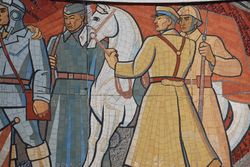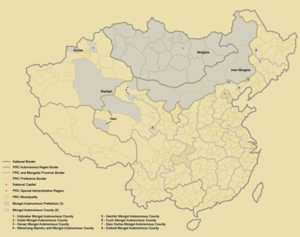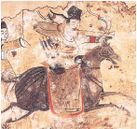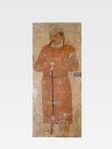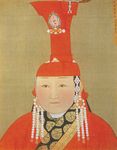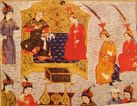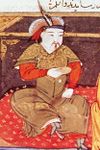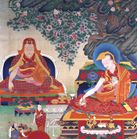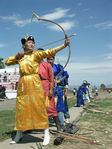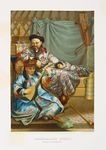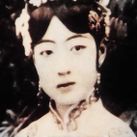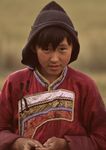منغول
| المناطق ذات التجمعات المعتبرة | |||||||||||||
|---|---|---|---|---|---|---|---|---|---|---|---|---|---|
| 2,921,287[1] | |||||||||||||
| 5,981,840 (2010)[2] | |||||||||||||
| 647,417[3] | |||||||||||||
| 34,000[4] | |||||||||||||
| 15,000–18,000[5] | |||||||||||||
| 12,000[6] | |||||||||||||
| 7,515[7] | |||||||||||||
| 5,401[8] | |||||||||||||
| 5,350[9] | |||||||||||||
| 3,852[8] | |||||||||||||
| 3,701[8] | |||||||||||||
| 2,859[8] | |||||||||||||
| 2,645[8] | |||||||||||||
| 2,523[8] | |||||||||||||
| 1,955[10] | |||||||||||||
| 1,500[8] | |||||||||||||
| اللغات | |||||||||||||
| اللغات المنغولية | |||||||||||||
| الدين | |||||||||||||
| الغالبية من البوذيين التبت، خلفية شامانية.[11][12][13][14] أقلية مسلمين سنة، مسيحيين أرثوذكس وپروتسنانت | |||||||||||||
| الجماعات العرقية ذات الصلة | |||||||||||||
| شعوب تونگوستية، شعوب توركية | |||||||||||||
| تاريخ المنغول |
|---|
| خط زمني • التاريخ • الدول |
|
المنغول Mongols، هي جماعة عرقية في آسيا الوسطى وشمال آسيا (آسيا الداخلية). بالرغم من أن المنغول يشكلون سكان منغوليا، إلا أنهم يتواجدون أيضاً كأقليات عبر شمال آسيا، ومنها روسيا، الصين، والكثير من دول الاتحاد السوڤيتي السابق. ينتمي المنغول إلى جماعة البوريات الفرعية التي تعيش فيما يعرف اليوم بجمهورية بورياتيا ذاتية الحكم وفي كالميكيا بروسيا. في الصين، يعيشون بشكل رئيسي إما في منغوليا الداخلية، أو في شينجيانگ، وكذلك في روسيا. Mongolian people belonging to the Buryat and Kalmyk subgroups live predominantly in the Russian federal subjects of Buryatia and Kalmykia.
يرتبط المنغول بثقافة ولغة مشتركة، جماعة لغوية مرتبطة تعرف باللغة المنغولية. The ancestors of the modern-day Mongols are referred to as Proto-Mongols.
التعريف
Broadly defined, the term includes the Mongols proper (also known as the Khalkha Mongols), Buryats, Oirats, the Kalmyk people and the Southern Mongols. The latter comprises the Abaga Mongols, Abaganar, Aohans, Baarins, Gorlos Mongols, Jalaids, Jaruud, Khishigten, Khuuchid, Muumyangan and Onnigud.
The designation "Mongol" briefly appeared in 8th century records of Tang China to describe a tribe of Shiwei. It resurfaced in the late 11th century during the Khitan-ruled Liao dynasty. After the fall of the Liao in 1125, the Khamag Mongols became a leading tribe on the Mongolian Plateau. However, their wars with the Jurchen-ruled Jin dynasty and the Tatar confederation had weakened them.
In the thirteenth century, the word Mongol grew into an umbrella term for a large group of Mongolic-speaking tribes united under the rule of Genghis Khan.[15]
| تاريخ المنغول |
|---|
 |
التاريخ
In various times Mongolic peoples have been equated with the Scythians, the Magog, and the Tungusic peoples. Based on Chinese historical texts the ancestry of the Mongolic peoples can be traced back to the Donghu, a nomadic confederation occupying eastern Mongolia and Manchuria. The identity of the Xiongnu (Hünnü) is still debated today. Although some scholars maintain that they were proto-Mongols, they were more likely a multi-ethnic group of Mongolic and Turkic tribes.[16] It has been suggested that the language of the Huns was related to the Hünnü.[17][18]
The Donghu, however, can be much more easily labeled proto-Mongol since the Chinese histories trace only Mongolic tribes and kingdoms (Xianbei and Wuhuan peoples) from them, although some historical texts claim a mixed Xiongnu-Donghu ancestry for some tribes (e.g. the Khitan).[19]
الأصول
انظر التاريخ الوراثي للآسيويين الشرقيين
في الكلاسيكيات الصينية
The Donghu are mentioned by Sima Qian as already existing in Inner Mongolia north of Yan in 699–632 BCE along with the Shanrong. Mentions in the Yi Zhou Shu ("Lost Book of Zhou") and the Classic of Mountains and Seas indicate the Donghu were also active during the Shang dynasty (1600–1046 BCE).
The Xianbei formed part of the Donghu confederation, but had earlier times of independence, as evidenced by a mention in the Guoyu ("晉語八" section), which states that during the reign of King Cheng of Zhou (reigned 1042–1021 BCE) they came to participate at a meeting of Zhou subject-lords at Qiyang (岐阳) (now Qishan County) but were only allowed to perform the fire ceremony under the supervision of Chu since they were not vassals by covenant (诸侯). The Xianbei chieftain was appointed joint guardian of the ritual torch along with Xiong Yi.
These early Xianbei came from the nearby Zhukaigou culture (2200–1500 BCE) in the Ordos Desert, where maternal DNA corresponds to the Mongol Daur people and the Tungusic Evenks. The Zhukaigou Xianbei (part of the Ordos culture of Inner Mongolia and northern Shaanxi) had trade relations with the Shang. In the late 2nd century, the Han dynasty scholar Fu Qian (服虔) wrote in his commentary "Jixie" (集解) that "Shanrong and Beidi are ancestors of the present-day Xianbei". Again in Inner Mongolia another closely connected core Mongolic Xianbei region was the Upper Xiajiadian culture (1000–600 BCE) where the Donghu confederation was centered.

After the Donghu were defeated by Xiongnu king Modu Chanyu, the Xianbei and Wuhuan survived as the main remnants of the confederation. Tadun Khan of the Wuhuan (died 207 AD) was the ancestor of the proto-Mongolic Kumo Xi.[20] The Wuhuan are of the direct Donghu royal line and the New Book of Tang says that in 209 BCE, Modu Chanyu defeated the Wuhuan instead of using the word Donghu. The Xianbei, however, were of the lateral Donghu line and had a somewhat separate identity, although they shared the same language with the Wuhuan. In 49 CE the Xianbei ruler Bianhe (Bayan Khan?) raided and defeated the Xiongnu, killing 2000, after having received generous gifts from Emperor Guangwu of Han. The Xianbei reached their peak under Tanshihuai Khan (reigned 156–181) who expanded the vast, but short lived, Xianbei state (93–234).
Three prominent groups split from the Xianbei state as recorded by the Chinese histories: the Rouran (claimed by some to be the Pannonian Avars), the Khitan people and the Shiwei (a subtribe called the "Shiwei Menggu" is held to be the origin of the Genghisid Mongols).[21] Besides these three Xianbei groups, there were others such as the Murong, Duan and Tuoba. Their culture was nomadic, their religion shamanism or Buddhism and their military strength formidable. There is still no direct evidence that the Rouran spoke Mongolic languages, although most scholars agree that they were Proto-Mongolic.[22] The Khitan, however, had two scripts of their own and many Mongolic words are found in their half-deciphered writings.
Geographically, the Tuoba Xianbei ruled the southern part of Inner Mongolia and northern China, the Rouran (Yujiulü Shelun was the first to use the title khagan in 402) ruled eastern Mongolia, western Mongolia, the northern part of Inner Mongolia and northern Mongolia, the Khitan were concentrated in eastern part of Inner Mongolia north of Korea and the Shiwei were located to the north of the Khitan. These tribes and kingdoms were soon overshadowed by the rise of the First Turkic Khaganate in 555, the Uyghur Khaganate in 745 and the Yenisei Kirghiz states in 840. The Tuoba were eventually absorbed into China. The Rouran fled west from the Göktürks and either disappeared into obscurity or, as some say, invaded Europe as the Avars under their Khan, Bayan I. Some Rouran under Tatar Khan migrated east, founding the Tatar confederation, who became part of the Shiwei. The Khitan, who were independent after their separation from the Kumo Xi (of Wuhuan origin) in 388, continued as a minor power in Manchuria until one of them, Ambagai (872–926), established the Liao dynasty (907–1125) as Emperor Taizu of Liao.
فترة الامبراطورية المنغولية ويوان الشمالية
The destruction of Uyghur Khaganate by the Kirghiz resulted in the end of Turkic dominance in Mongolia. According to historians, Kirghiz were not interested in assimilating newly acquired lands; instead, they controlled local tribes through various manaps (tribal leader). The Khitans occupied the areas vacated by the Turkic Uyghurs bringing them under their control. The Yenisei Kirghiz state was centered on Khakassia and they were expelled from Mongolia by the Khitans in 924. Beginning in the 10th century, the Khitans, under the leadership of Abaoji, prevailed in several military campaigns against the Tang Dynasty's border guards, and the Xi, Shiwei and Jurchen nomadic groups.[23]
The Khitan fled west after being defeated by the Jurchens (later known as Manchu) and founded the Qara Khitai (1125–1218) in eastern Kazakhstan. In 1218, Genghis Khan destroyed the Qara Khitai after which the Khitan passed into obscurity. With the expansion of the Mongol Empire, the Mongolic peoples settled over almost all Eurasia and carried on military campaigns from the Adriatic Sea to Indonesian Java island and from Japan to Palestine (Gaza). They simultaneously became Padishahs of Persia, Emperors of China, and Great Khans of Mongolia, and one became Sultan of Egypt (Al-Adil Kitbugha). The Mongolic peoples of the Golden Horde established themselves to govern Russia by 1240.[24] By 1279, they conquered the Song dynasty and brought all of China under control of the Yuan dynasty.[24]
With the breakup of the empire, the dispersed Mongolic peoples quickly adopted the mostly Turkic cultures surrounding them and were assimilated, forming parts of Azerbaijanis, Uzbeks, Karakalpaks, Tatars, Bashkirs, Turkmens, Uyghurs, Nogays, Kyrgyzs, Kazakhs, Caucasaus peoples, Iranian peoples and Moghuls; linguistic and cultural Persianization also began to be prominent in these territories. Some Mongols assimilated into the Yakuts after their migration to Northern Siberia and about 30% of Yakut words have Mongol origin. However, most of the Yuan Mongols returned to Mongolia in 1368, retaining their language and culture. There were 250,000 Mongols in Southern China and many Mongols were massacred by the rebel army. The survivors were trapped in southern china and eventually assimilated. The Dongxiangs, Bonans, Yugur and Monguor people were invaded by Chinese Ming dynasty.
After the fall of the Yuan dynasty in 1368, the Mongols continued to rule the Northern Yuan dynasty in Mongolia homeland. However, the Oirads began to challenge the Eastern Mongolic peoples under the Borjigin monarchs in the late 14th century and Mongolia was divided into two parts: Western Mongolia (Oirats) and Eastern Mongolia (Khalkha, Inner Mongols, Barga, Buryats). The earliest written references to the plough in Middle Mongolian language sources appear towards the end of the 14th c.[25]
In 1434, Eastern Mongolian Taisun Khan's (1433–1452) prime minister Western Mongolian Togoon Taish reunited the Mongols after killing Eastern Mongolian another king Adai (Khorchin). Togoon died in 1439 and his son Esen Taish became prime minister. Esen carried out successful policy for Mongolian unification and independence. The Ming Empire attempted to invade Mongolia in the 14–16th centuries, however, the Ming Empire was defeated by the Oirat, Southern Mongol, Eastern Mongol and united Mongolian armies. Esen's 30,000 cavalries defeated 500,000 Chinese soldiers in 1449. Within eighteen months of his defeat of the titular Khan Taisun, in 1453, Esen himself took the title of Great Khan (1454–1455) of the Great Yuan.[26]
The Khalkha emerged during the reign of Dayan Khan (1479–1543) as one of the six tumens of the Eastern Mongolic peoples. They quickly became the dominant Mongolic clan in Mongolia proper.[27][28] He reunited the Mongols again. The Mongols voluntarily reunified during Eastern Mongolian Tümen Zasagt Khan rule (1558–1592) for the last time (the Mongol Empire united all Mongols before this).
Eastern Mongolia was divided into three parts in the 17th century: Outer Mongolia (Khalkha), Inner Mongolia (Inner Mongols) and the Buryat region in southern Siberia.
The last Mongol khagan was Ligdan in the early 17th century. He got into conflicts with the Manchus over the looting of Chinese cities, and managed to alienate most Mongol tribes. In 1618, Ligdan signed a treaty with the Ming dynasty to protect their northern border from the Manchus attack in exchange for thousands of taels of silver. By the 1620s, only the Chahars remained under his rule.
ظلت القبائل في منازعاتها وتمزقها حتى بزغ نجم بطلهم التاريخي العظيم جنكيزخان Khan Genghis الذي وحّد تحت إمرته قبائل المغول والأتراك ، وابتدأ فتوحه في شمال الصين فأخضع معظمها، ثم اتـجه غرباً، فدمَّر الدولة الخوارزمية العظيمة – وكانت في ذروة قوتها – واحتل ممالكها على التـتابع : بلاد ما وراء النهر ثم خراسان ثم فارس.
وفي طريقهم.. دمّر المغول دولة "الإسماعيليين الحشّاشين"- في إيران- الذين كانوا مصدر إرهاب وخوف للمسلمين ، إذ كانوا قد اغتالوا عدداً من قادة ذلك العصر المخالفين لمذهبهم أمثال الوزير السلجوقي(نظام الملك) ثم ابنه من بعده!
ولم يدم فرح المسلمين طويلاً بهذا الخلاص من الإرهابيين الحشاشين ،حيث تابعت جحافل المغول فتوحاتها، حتى دخلت بغداد عنوةً (656هـ) بعد مقاومة باسلة من حامية بغداد ،ولذلك –وكما يكون مصير كل من يقاومهم- قـتل المغول الخليفةَ العباسيَّ ، و قتلوا حاميةَ بغداد ونكَّلوا بأهلها.
ثم اجتاحوا بلاد الشام و دخلوا دمشق (في مارس 1260م = 658هـ) -وهنا ، وفي هذا الوقت - يصل بالبريد خبر موت الخاقان الأعظم للمغول (منكوخان) في قراقورم ويُستدعى أولاد وأحفاد جنكيز خان إلى مجلس الشورى المغولي ( الكوريل تاي Kuriltai ) لانتخاب الخان الأعظم الجديد للإمبراطورية؛ فيرجع هولاكو (وهو أخو منكو خان ، وأحد المؤهّلين للعرش ) بمعظم جيشه إلى فارس ،ليتابع أمور العاصمة المغولية (قراقوروم بمنغوليا ) عن كثب، و لا يترك في بلاد الشام إلا جيشاً صغيراً من المغول (عشرة آلاف جندي فقط) بقيادة أحد أبرز ضباطه واسمه كيتوبوقا أو كتبغا (و هو قائد عسكري محنك من قبيلة النايمان التركية).
فترة چينگ وما بعدها



خرج المنغول من منغوليا في وسط آسيا وأسس دولتين كبيرتين، الأولى: في آسيا الوسطى وأسسها جنكيز خان ووزعها بين أبنائه ومنهم جغتاي، وتعرف سلالته بالمغول العظماء. والدولة الثانية أقيمت في الهند من 1526 - 1858 وقد أسسها بابر وهو من احفاد تيمور لنك وعرفت بمغول الهند لارتباط تيمور لنك من جهة أمه بجنكيز خان. انجبت هذه الامبراطورية 19 امبراطوريا اشتهر منهم الستة الأول الذي حكموا من 1526 - 1707. وهم مغول الهند العظماء: بابر، همايون، أكبر، جهانكير، شاهجان، اورنك زيب. أما الباقون الذين حكموا من 1707 - 1858 فقد حكموا بالاسم فقط وتميزوا بضعفهم، وكان آخرهم بهادر شاه الثاني الذي عزله الانجليز عام 1858. َ
اللغات
الديانة
والمسيحية والإسلام
العسكرية
نذكر هنا مرة أخرى أنالجيش المملوكي كان كله تركياً قيادةً وجنوداً، وكان يتألف من الأقسام التالية:
- المماليك السلطانية: وكانوا من الأتراك الذين يجلبون من بلاد القبجاق.
- جند الحلقة: تتكون من محترفي الجندية من أولاد المماليك، وقد عرفوا أيضا باسم أولاد الناس، وهم كثرة الجيش و عامته في أثناء الحرب؛ و هم أيضًا أصحاب حرفٍ وصناعاتٍ في وقت السلم.
- مماليك الأمراء: شبيهة بالمماليك السلطانية ؛ غير أن أفرادها يتبعون أمراءهم.
نظام الحكم والمجتمع
- النظام الدقيق الصارم الذي يستند إلى نصوص الياسا والذي ضبط الحياة ضبطاً صارماً حفظ الأمن في ربوع أكبر إمبراطورية عرفها التاريخ.
- ياسا YASA= يَسَق: تحريف للكلمة المغولية "دزاساق Dzasak "؛ وهي مجموع القوانين التشريعية المغولية التي جمع مادتها جنكيز خان ونظَّمَها وطوَّرها، ثم جعلها القانون الأساسي للإمبراطورية المغولية.
- تنظيم أعظم وأسرع شبكةٍ بريديةٍ عرفها التاريخ من قبل!– ربطوا بها الإمبراطورية بأجزائها الفسيحة، وكذلك – وبجوارها- نُظِّمَتْ أسلم وآمن و أعظم خطوط التجارة بحيث ربطت العالم القديم بعضه ببعض فأصبحت الصين التي كانت في عزلة -قبل عهد المغول - أصبحت حاضرة (قوبيلاي ابن جنكيزخان) الخان الأعظم للمغول، وصارت هي وجاراتها على اتصال موثوق ممهد مأمون مع أوربا ومع العالم الإسلامي كله.
كان لهذا الانجاز دور عظيم في تلاقح الثقافات، شرقيّها وغربيّها، في ظلال إمبراطورية المغول ؛ وأنت تجد هذا واضحاً بـيّناً في البعثات الرسولية البابوية من روما إلى خان باليك (بكين حالياً ) مقر عاصمة المغول ومنها إلى قرا قورم عاصمتهم في منغوليا
- التسامح الديني العظيم مع جميع الديانات، السماوية منها وغير السماوية وعدّها جميعاً طرقاً مختلفة إلى هدفٍ واحدٍ وهو عبادة الله.
الأعداد التاريخة للسكان
| السنة | السكان | هوامش |
|---|---|---|
| 1 م | 1–2,000,000? | |
| 1000 | 2,500,000? | 750,000 كيتان |
| 1200 | 2,600,000? | 1,5-2,000,000 Mongols |
| 1600 | 2,300,000? | 77,000[29][30] Buryats; 600,000 Khalkhas |
| 1700 | 2,600,000? | 600,000 Khalkhas; 1,100,000? Oirats: 600,000 Zunghars, 200–250,000? Kalmyks, 200,000 Upper Mongols[31] |
| 1800 | 2,000,000? | 600,000 Khalkhas; 440,000? Oirats: 120,000 Zunghars, 120,000? Upper Mongols |
| 1900 | 2,300,000? | 283,383[32] Buryats (1897); 500,000? Khalkhas (1911); 380,000 Oirats: 70,000? Mongolian Oirats (1911), 190,648 Kalmyks (1897), 70,000? Dzungarian and Southern Mongolian Oirats, 50,000 Upper Mongols;[31] 1,500,000? Southern Mongols (1911) |
| 1927 | 2,100,000? | 600,000 منغولي[33] — 230,000? Buryats: 15,000? Mongolian Buryats, 214,957 Buryats in Russia (1926); 500,000? Khalkhas (1927); 330,000? Oirats: 70,000 Mongolian Oirats, 128,809 Kalmyks (1926) |
| 1956 | 2,500,000? | 228,647 Buryats: 24,625 Mongolian Buryats (1956), 135,798 Buryats of the (Buryat Autonomous Soviet Socialist Republic; 1959), 23,374 Agin-Buryats (1959), 44,850 Ust-Orda Buryats (1959); 639,141 Khalkhas (1956); 240,000? Oirats: 77,996 Mongolian Oirats (1956), 100,603 Kalmyks (1959), 1,462,956 Mongols in China (1953) |
| 1980 | 4,300,000? | 317,966? Buryats: 29,802 Mongolian Buryats (1979), 206,860 Buryatian Buryats (1979), 45,436 Usta-Orda Buryats (1979), 35,868 Agin-Buryats (1979); 1,271,086 Khalkhas; 398,339 Oirats: 127,328 Mongolian Oirats (1979), 140,103 Kalmyks (1979), 2,153,000 Southern Mongols (1981)[34][35] |
| 1990 | 4,700,000? | 376,629 Buryats: 35,444 Mongolian Buryats (1989), 249,525 Buryatian Buryats (1989), 49,298 Usta-Orda Buryats (1989), 42,362 Agin-Buryats (1989); 1,654,221 Khalkhas; 470,000? Oirats: 161,803 Mongolian Oirats (1989), 165,103 Kalmyks (1989), 33,000 Upper Mongols (1987);[36] |
| 2010 | 5–9,200,000?[37] | 500,000? Buryats (45–75,000 Mongolian Buryats, 10,000 Hulunbuir Buryats); 2,300,000 Khalkhas (including Dariganga, Darkhad, Eljigin and Sartuul); 638,372 Oirats: 183,372 Kalmyks, 205,000 Mongolian Oirats, 90–100, 000 Upper Mongols, 2010 — 140,000 Xinjiang Oirats; 2013 — 190,000? Xinjiang Oirats: 100,000? Torghuts (Kalmyks), 40–50,000? Olots, 40,000? other Oirats: mainly Khoshuts); 1,5–4,000,000? 5,700,000? Southern Mongols[34] |

الانتشار الجغرافي
يشكل المنغول نسبة 85% من عدد سكان منغولية حيث يصل عددهم إلى 2.7 مليون نسمة.
منغوليا الشرقية
منغوليا الشمالية
منغوليا الجنوبية
منغوليا الغربية
منغوليا
الصين
تبعا لتقديرات سكان الصين في 2000 وصل عدد المغول إلى 5.8 مليون نسمة في الصين. ومعظمهم يعيشون في إقليم منغوليا الداخلية، يليه مقاطعة لياونج. ويوجد عدد قليل من المنغول في مقاطعات قريبة من هاتين المنطقتين.
روسيا
الهند

هم سلالة من المغول المسلمين، وصلوا إلى الحكم في الهند في مطلع القرن السادس عشر وحتى نهاية القرن ذاته سيطروا على معظم أنحاء آسيا. امتاز حكم المغول في الهند بنجاعته الممتازة واتسم بالقدرة التنظيمية والإدارية والتي تستحق التقدير، وقد حاول المغول والذين كانوا يدينون بالديانة الإسلامية ، حاولوا الدمج بين المؤمنين الهندوس وبين المؤمنين المسلمين، وذلك بهدف التوصل إلى وحدة وعلاقة صداقة في الهند. عاصمة المغول كانت دلهي ، حيث طوروها وبنوا فيها مباني رائعة، ومع غزو حاكم إيران نادر شاه لشمال الهند في عام 1739 بدأت معها بداية نهاية المغول. بالرغم من استمرار الحكام المغول بالسيطرة على منطقة دلهي مئة سنة أخرى بعد ذلك، حتى سقوط الإمبراطورية المغولية، ولكن في الواقع فقد المغوليون قوتهم الحقيقية قبل ذلك بكثير.
الفترة المُمتدة بين منتصف القرن السادس عشر تميزت بنشاط وتطور لم يسبق له مثيل في الفنون الهندية الإسلامية ، امتازت الفنون الإسلامية في الهند في أساسها بالدمج بين التقاليد الهندوسية والتقاليد الإسلامية. أحد المجالات التي أبدع فيها المغول هو فن العمارة ، حيثُ قاموا ببناء القصور ، المساجد ، والمباني الأخرى ، والتي بقي منها الكثير حتى يومنا هذا محافظاً عليه. لا شك أن أشهرها هو تاج محل في مدينة أجرة في الهند. والذي تم بناؤه بين السنوات 1631 – 1653. [38]
أماكن أخرى
معرض الصور
4th century Mongolic Xianbei archer
Guard at tomb of Xianbei Emperor Xuanwu (483-515).
Khitan Pagoda of Fogong Temple, 1056
Mongol Empress Zayaat (Jiyatu), wife of Kulug Khan (1281–1311)
Genghis' son Tolui with Queen Sorgaqtani
A 20th-century Mongol Khan, Navaanneren
The 4th Dalai Lama Yonten Gyatso
Dolgorsürengiin Dagvadorj became the first Mongol to reach sumo's highest rank.
Mongol women archers during Naadam festival
Mongol girl performing Bayad dance
Daur Mongol Empress Wanrong (1906-1946), also had Borjigin blood on maternal side.
انظر أيضاً
|
المصادر
- ^ "Монголын үндэсний статистикийн хороо". National Statistical Office of Mongolia. Retrieved 2013-11-14.
- ^ ديموغرافيا الصين
- ^ 2,656 Mongols proper, 461,389 Buryats, 183,372 Kalmyks (Russian Census (2010))
- ^ "'Korean Dream' fills Korean classrooms in Mongolia", The Chosun Ilbo, 2008-04-24, http://english.chosun.com/w21data/html/news/200804/200804240009.html, retrieved on 2009-02-06[dead link]
- ^ Bahrampour, Tara (2006-07-03). "Mongolians Meld Old, New In Making Arlington Home". The Washington Post. Retrieved 2007-09-05.
- ^ President of Mongoli Received the Kalmyk Citizens of the Kyrgyz. 2012
- ^ "Latest numbers show 7,500 Mongolians working in Czech Republic", Mongolia Web, 2008-02-19, http://www.mongolia-web.com/content/view/1630/2/, retrieved on 2008-10-04
- ^ أ ب ت ث ج ح خ Mongolia National Census 2010 Provision Results. National Statistical Office of Mongolia (Mongolian)
- ^ NHS Profile, Canada, 2011
- ^ "Bevölkerung nach Staatsangehörigkeit und Geburtsland" (in German). Statistik Austria. 3 July 2014. Retrieved 21 August 2014.
{{cite web}}: Unknown parameter|trans_title=ignored (|trans-title=suggested) (help)CS1 maint: unrecognized language (link) - ^ National Bureau of Statistics of the People's Republic of China (April 2012). Tabulation of the 2010 Population Census of the People's Republic of China. China Statistics Press. ISBN 978-7-5037-6507-0. Retrieved 2013-02-19.
- ^ China Mongolian, Mongol Ethnic Minority, Mongols History, Food
- ^ China.org.cn – The Mongolian ethnic minority
- ^ China.org.cn – The Mongolian Ethnic Group
- ^ "Mongolia: Ethnography of Mongolia". Encyclopædia Britannica. Retrieved 2007-07-22.
- ^ Geng 2005
- ^ Étienne de la Vaissière, Xiongnu. Encyclopædia Iranica online, 2006
- ^ Dr. Obrusánszky, Borbála : The History and Civilization of the Huns. Paper of the University of Amsterdam, 8 October 2007. Page 60. PDF
- ^ Frances Wood, The Silk Road: two thousand years in the heart of Asia, p. 48
- ^ Xin Tangshu 219. 6173.
- ^ University of California, Berkeley. Project on Linguistic Analysis, Journal of Chinese linguistics, p. 154
- ^ Thomas Hoppe, Die ethnischen Gruppen Xinjiangs: Kulturunterschiede und interethnische, p. 66
- ^ San, Tan Koon (2014-08-15). Dynastic China: An Elementary History. The Other Press. ISBN 978-983-9541-88-5.
- ^ أ ب Jerry Bentley, "Old World Encounters: Cross-Cultural Contacts and Exchange in Pre-Modern Times (New York: Oxford University Press, 1993), 136.
- ^ MOLNÁR, ÁDÁM. "THE PLOUGH AND PLOUGHING AMONG THE ALTAIC PEOPLES." Central Asiatic Journal 26, no. 3/4 (1982): 215-24.
- ^ Sechin Jagchid, Van Jay Symons – Peace, war, and trade along the Great Wall: Nomadic-Chinese interaction through two millennia, p.49
- ^ Janhunen, Juha The Mongolic languages, p.177
- ^ Elizabeth E. Bacon Obok: A Study of Social Structure in Eurasia, p.82
- ^ http://www.bur-culture.ru/index.php?id=news-detail&tx_ttnews[tt_news]=42&cHash=effe903f9ae6737362277ed761d6c2ca Традиционная материальная культура бурятского этноса Предбайкалья. Этногенез и расселение. Средовая культура бурят (Russian)
- ^ П.Б. Абзаев. Буряты на рубеже XX-XXI вв. Численность, состав, занятия (Russian)
- ^ أ ب خطأ استشهاد: وسم
<ref>غير صحيح؛ لا نص تم توفيره للمراجع المسماةmontaa.mn - ^ Б.З. Нанзатов,ПЛЕМЕННОЙ СОСТАВ БУРЯТ В XIX ВЕКЕ (Russian)
- ^ ИРГЭНИЙ БҮРТГЭЛИЙН ТҮҮХЭН ТОЙМ (Mongolian)
- ^ أ ب Түмэдхүү, ӨМӨЗО-НЫ ХҮН АМЫН ХУВИРАЛТЫН ЗУРГИЙГ ҮЗЭЭД (Southern) Mongolian Liberal Union Party (Mongolian) Millions of Han Chinese registered as "Mongol" and "Manchu" according to Chinese policy since the 1980s.There is no enough information about Chinese ethnic minorities due to the government policy.
- ^ Өвөр Монголын хүн ам (Mongolian)
- ^ ethnologue.com information
- ^ 768,000 أسرة في منغوليا (2013).
- ^ المرشد للفنون الإسلامية
وصلات خارجية
- Articles with dead external links from September 2010
- CS1 errors: unsupported parameter
- صفحات بالمعرفة فيها قوالب حماية خاطئة
- صفحات شبه محمية للأبد في المعرفة
- Pages using infobox ethnic group with unsupported parameters
- Articles using infobox ethnic group with image parameters
- Articles with hatnote templates targeting a nonexistent page
- مغول
- منغوليا
- تاريخ منغوليا














